| We chose the camp site because it says there is a
cycle track across the park to the town. It omits to say it is over 10
miles! However there is a a park and ride with a bus service into the city. So we took the RV but
let the bus take the strain. The bus trip is interesting because Ottawa has
exclusive bus roads (along former rail tracks, I think) and it deposited us
in the centre of town close to the Parliament buildings. However 1st July
(tomorrow) is Canada Day and an excuse for a big party - hence the sound
stage being set up on Parliament Square. | 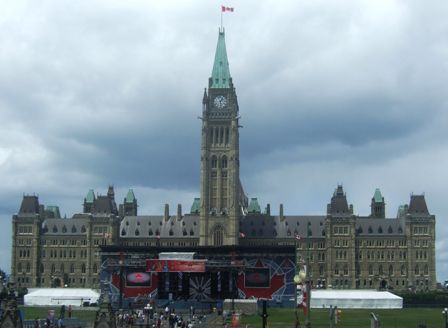 |
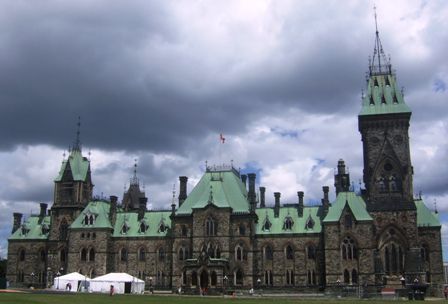 |
Parliament Square is enclosed on three sides by the Parliament Buildings.
This is the East wing, mainly offices these days although they have just
started to give a tour there. The buildings were mostly built between 1859
and 1866. A new centre block was completed in 1922 following the fire and
the 'Peace Tower' (clock tower) in 1927. |
| The buildings are fairly impressive although obviously not as
old as the English Parliament building. This is the main building from the
rear. You can walk all the way round and although there is security it isn't
evident as in the UK or in your face as it is in the US. There is a free
tour of the inside but it is first come first served and all the places go
by about 1100hrs. | 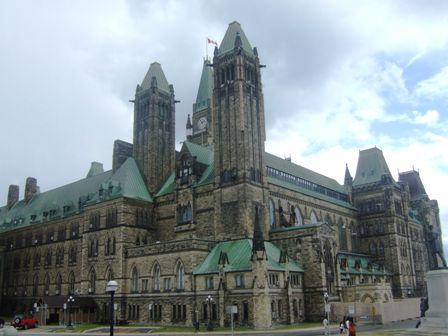 |
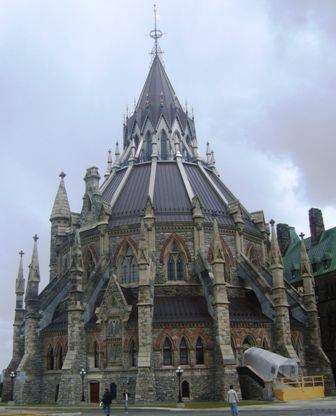 |
The most spectacular part (externally) is at the rear and is the library.
Built in 1876, it
looks more like a cathedral with all the flying buttresses. It is a joint
library for both the houses, the House of Commons, and a more senior
Senate. There are more than 17km of materials on its shelves including the
records of proceedings which are known as Hansard, as in England. It is currently undergoing repair, restoration and upgrading to more
modern standards. |
| In the grounds is the Victoria bell which used to hang in the
tower (like Big Ben). It was cast in Troy (New York) in 1875 and was removed
from the ruins of the tower when the old Parliament buildings caught fire on
Feb 3rd 1916. The fire reached the tower at 9pm and the bell continued to
chime until the last stroke of midnight when the blazing tower collapsed. | 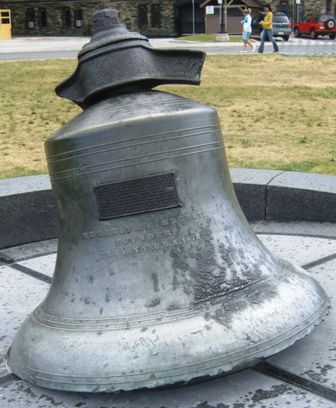 |
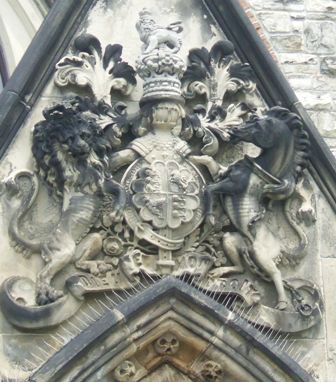 |
Some of the stonework of the buildings, particularly around the doors, is
very impressive as with this coat of arms. Canada now
has its own court of heralds and can award its own coats of arms. This power was
devolved by the Queen (Head of State) to the Governor General. |
| This unique water feature, the Centennial Flame, has water cascading from the
centre past shields depicting the coats of arms of each of the provinces
with their
symbolic flowers on the edge wall. An eternal flame burns at the centre
(which you can just see) and is powered by Canadian natural gas. The barriers are part of the crowd control
arrangements for tomorrow's concert and are not normally there. | 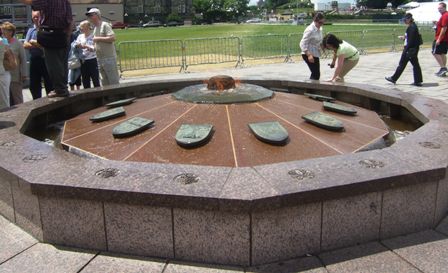 |
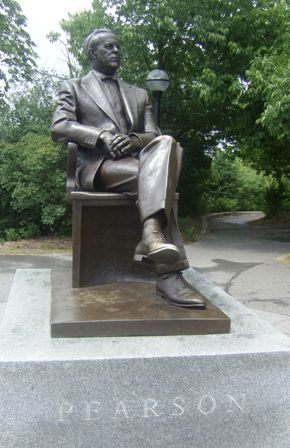 |
Most (all?) of Canada's Premiers have their statues somewhere in the square.
These two are Lester Pearson (1963-8) and John Diefenbaker (1957-63), two of
the more famous (I'd heard of them!). The former won the Nobel Peace prize
for creating the UN peacekeeping forces and the latter steered Canada's Bill
of Rights through parliament. |
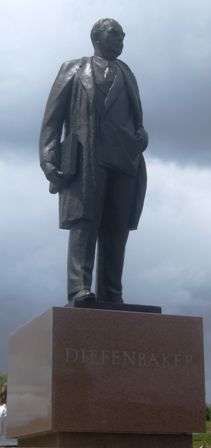 |
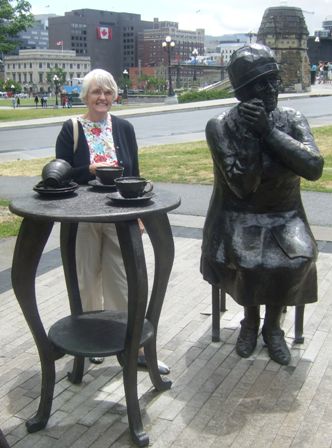 |
There are a lot of bronze statues about including a set of five
celebrating the Person's case of 1929 which basically made women 'persons'
and thus eligible for appointment to the Senate and other government
positions. The statues are of five women who became the first in positions
of authority eg prime minister, governor general. Jan was
thirsty and the Canadians do understand about tea, unlike Americans who
don't. |
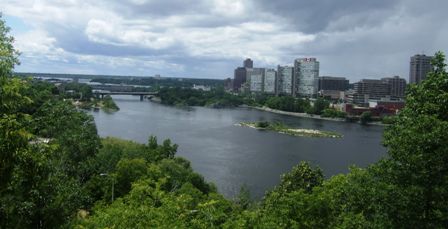 |
The Parliament Buildings are on a cliff above the river on the north side of
which is the city of Gatineau, originally called Hull. Ottawa is in Ontario,
but Gatineau is in Quebec. It was one of the least favoured options for a
capital, being so far from the major transport route of the St Lawrence, but Canadians could not agree between Quebec and Ontario towns, so
the decision was left to Queen Victoria. Even so, it still took some years
before her choice was ratified by the Canadians. |
| This impressive looking building is in Gatineau and is
the Canadian Museum of Civilisation. | 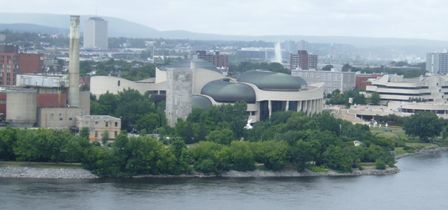 |
On the southern edge of the Parliament Buildings is the War Memorial and a
collection of bronzes of fourteen important figures in Canadian
history. I picked these three to show here and they are (left to right):
Laura Secord, thanks to whom over 500 Americans surrendered in 1813 at
Beaver Dams thus avoiding a British defeat. She had overheard plans for a
surprise attack by them on the British outpost and struggled through the dense
brush to warn the British commander.
Lieutenant Colonel John Butler (1728-1796) who gathered backwoods
intelligence and raised an aboriginal army (Butlers Rangers) to fight in the
American Revolution in support of the British from Kentucky to Niagara.
Pierre Le Moyne D'Iberville (1661-1706) who was born in Montreal and was a bold and
brilliant commander. In 1697 when three British ships attacked his ship (the Pelican) in
Hudson's Bay, he sank one, boarded another and then captured the outpost at
York.
| The war memorial commemorates all the Canadian dead in all the
wars in which Canadian forces have fought. Below it is the tomb of the
unknown soldier which is guarded by a ceremonial regiment of guards. They also have a
changing of the guard ceremony daily for the tourists. They are just like
our guards and remain impassive despite the hundreds of tourists lining up
to have their photographs taken. They do move occasionally and in perfect
unison to 'stretch their legs'. | 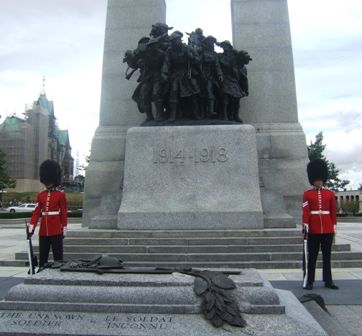 |
|